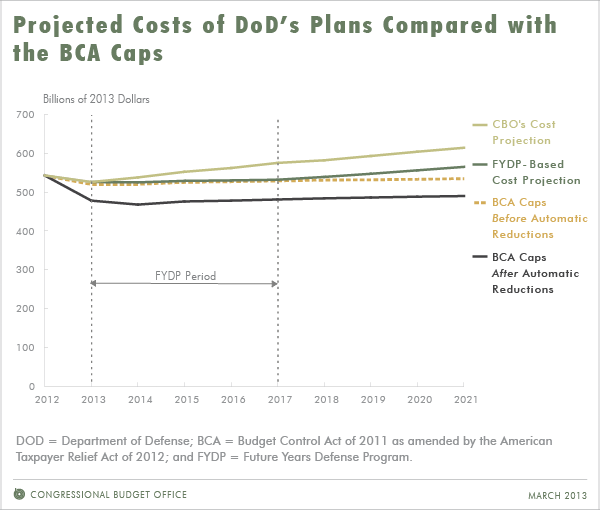CBO: Approaches for Scaling Back DoD's Budget Plans
It is a well-known fact that the U.S. spends a sizeable amount on defense, more than the next 15 countries combined, including China and Russia. But the Budget Control Act (BCA) discretionary spending caps will require the Pentagon to rein in spending levels, even if sequestration is replaced.
The Congressional Budget Office explores strategies for reducing defense spending in a new report, "Approaches for Scaling Back the Defense Department's Budget Plans." The Defense Department projects for five years the expected cost of its defense plans in an annual report every March, the Future Years Defense Program. However, CBO's analysis of this report last summer showed that under less favorable -- and arguably more realistic -- assumptions of cost growth, spending in DoD's plan would exceed the amount allotted to defense under the BCA caps, and would not come close to meeting the levels under sequestration (naturally, since the Administration wanted to replace the sequester).
In the report, CBO presents several options to meet the BCA caps under its more realistic cost projection baseline, with different combinations of reductions to force structure (overall size of force), acquisitions, and operations. While reducing force structure would likely lead to additional related savings in acquisitions and operations, CBO also identifies possible savings without reducing force structure through civilian and military pay freezes, TRICARE reform, and procurement reform. CBO provides four illustrative options that would include a combination of savings in different areas:
- Option 1: Preserve Force Structure; Cut Acquisition and Operations. Due to force structure being entirely preserved, this option would require a 31 percent cut to spending on acquisition and operations by 2021.
- Option 2: Cut Acquisition and Operations; Phase in Reductions in Force Structure. With acquisitions and operations being cut first, reductions in force size could be phased in, although spending related to force size would be 11 percent less by 2021.
- Option 3: Achieve Savings Primarily by Reducing Force Structure. Although cuts to acquisitions and operations would allow a transition, spending related to force size would be reduced by 23 percent by 2021.
- Option 4: Reduce Force Structure Under a Modified Set of Budget Caps. This option would make cuts entirely through reductions to force structure, although it would use modified caps to allow for a smoother transition. Spending to maintain force size would have to be reduced by 25 percent by 2021.
CBO illustrates how difficult it will be to meet the caps without taking a look at the whole defense budget and allocating resources according to the greatest priorities. Without making reductions to force structure, other areas of the Defense budget would need to be cut dramatically, which could result in the U.S. losing its technological superiority or its ability to maintain its volunteer force. On the other hand, as CBO points out, a smaller force would be less able to engage in long or multiple conflicts, possibly limiting military capabilities. Many plans that reduce defense spending also call for a change of military strategy in line with the reallocation of resources proposed in the plan. CBO's report demonstrates the trade-offs that come with matching the budget to the military's overarching strategy.
The full CBO report can be found here.




